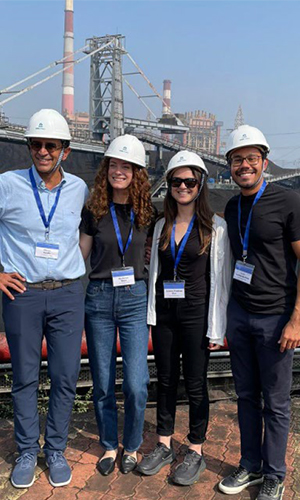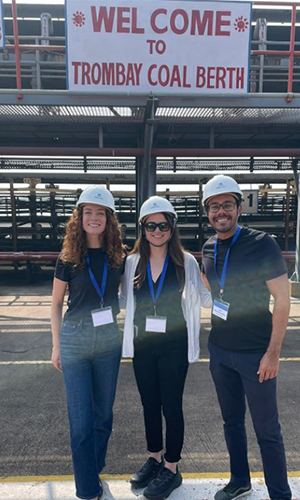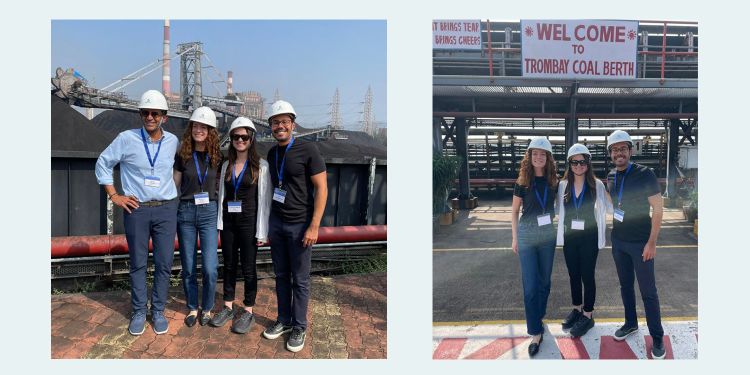Professor Vikram Gandhi’s Immersive Field Course (IFC) “Development while Decarbonizing: India’s Path to Net-Zero" delved into the critical aspect of decarbonization and sustainability goals amid India's rapid development. The course presented an opportunity for students to advance their knowledge of sustainability efforts, decarbonization, and net zero in the context of a broader development agenda. The class culminated in a series of site visits in January 2024 in Mumbai and Bangalore and this is one of 14 student essays that highlights their reflections on uncovering sustainable solutions across the country.
HBS visited Tata Power’s Trombay Power Station on a sunny Mumbai day. Despite the temperate weather, visibility was quite low due to significant air pollution – an AQI of over 200 – which reflects PM 2.5 levels well above the World Health Organization’s recommended exposure caps (1). The culprit, however, was not the mammoth coal fired power plant under our feet. In fact, Tata Power equipped Trombay with state-of-the-art air pollution mitigation technology to minimize both NOx and SOx emissions, as well as minimize coal dust entering the surrounding air. Nevertheless, the most advanced air pollution control mechanisms in the world could not stop that plant from pouring CO2 into the air at astonishing rates. Despite a few usages of the term “green coal” by our gracious hosts, that term is nothing more than a fantasy. While we could not see the emissions from the plant – the plume was cleaner than most you would see the United States – the invisible emissions were substantial (according to our hosts, about 12 tons of CO2 were emitted every day by the plant).

The unfortunate reality of an aging coal plant like Trombay is that the only way to significantly reduce emissions is to shut it down. That is a difficult proposition in the context of India’s rapidly expanding economy where demand for stable, uninterrupted power is growing. Mumbai, like much of India, has a fast-growing population with increasing energy needs. To meet this demand, Trombay can run nearly 24/7, with limited downtime mostly for planned maintenance work. It does not need sun or wind to operate at full capacity, and while the operators chose to use higher quality imported Indonesian coal to run the plant, in a pinch they could switch over to the domestically mined, lower quality coal that is abundant in India. In fact, Tata Power has already demonstrated their ability to address changing market trends within this plant. The Trombay plant began as an oil thermal plant but switched to coal around 70s-80s to mitigate oil price fluctuations in the market and provide India with greater energy security. Indeed, from an energy security perspective, Trombay’s value proposition is unmatched with its reliability as a baseload power source and its ability to flex between imported and domestic coal.
This brings us to the real issue – the crux of our entire IFC trip: how can India continue to develop while decarbonizing its energy use? The reality is that today, 60% of India’s electric power comes from coal plants like Trombay, which play a critical role in continued economic growth. That figure is much higher than in the United States (15%) and about on par with China. As much as we might want India to replace coal capacity with renewable generation resources overnight, it is impossible for two reasons. First, most obviously, it is not realistic to build thousands of gigawatts of solar and wind plants quickly. Projects are capital intensive and must go through significant red tape to secure land rights and permits. Second, and more difficult to surmount, is the fact that without significant electricity storage capacity, the intermittent nature of renewable power makes it an imperfect substitute for electric power from fossil fuels. The sun is not always shining, the wind is not always blowing. Coal, however, can always burn.
So how, then, can India transition away from coal power? Its plants – despite the sophistication of the one we visited – are some of the dirtiest in the world in terms of carbon dioxide emissions. There are only two sources of non-intermittent, carbon free power in the world today: hydroelectric power and nuclear power. Our hosts were happy to highlight their planned investments in additional hydropower, including two new pumped storage facilities. They also highlighted expansive investments in renewable capacity across India, with an impressive monitoring system. However, the truth is that opportunities to add capacity with new dams are limited. Building dams is difficult due to the complex siting requirements and opposition from local residents who are often displaced to build the reservoirs. Pumped hydro, while helpful for some storage, is not viable at the scale of energy storage India requires.
Nuclear power, on the other hand, is already growing in India and plants can be located on more compact parcels. At present, there are several new reactors under construction leveraging a fully “made-in-India” design. Potential for further expansion at the scale needed to significantly displace coal capacity, however, is constrained by tight regulation of private and foreign investment in the industry. Tata Power, and other private and foreign firms are standing by should those regulations change, as the government has discussed (2). As recently as January 2024, the Government of India has discussed collaborating with France on small nuclear reactors, and the US government has indicated similar interest (3). A scenario involving an opening up of the nuclear sector coupled with rapid expansion of solar and wind renewables capacity holds some promise for India being able to achieve its growth targets without adding to its carbon footprint.
For most HBS students attending the IFC, the visit to Trombay Power Station was the first time they saw a fossil fuel plant up close. The massive structure is a fascinating feat of engineering and an example of high technological investment in lower NOx and SOx emissions. We were grateful for our hosts’ warm welcome and investment in our educational journey, and for the opportunity to see a power plant in action. Let us hope, however, that in a few decades we can look back on this time as a historical visit to a now-extinct coal-fired power plant, replaced by new Tata investments in nuclear energy and a further expanded renewable energy portfolio.

Sources
1. https://www.who.int/news-room/feature-stories/detail/what-are-the-who-air-quality-guidelines
2. https://www.reuters.com/world/india/india-considering-allowing-foreign-investment-nuclear-power-sources-2023-05-05/
3. https://www.bloomberg.com/news/articles/2024-01-24/france-and-india-discuss-partnering-on-small-nuclear-reactors-as-macron-visits

